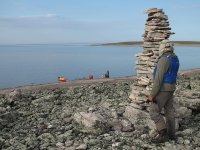- Joined
- Aug 21, 2018
- Messages
- 1,808
- Reaction score
- 4,508
Kathleen and I paddled the Thelon River in 1993, and encountered many Inuit structures along Aberdeen Lake. The word “inukshuk” means “in the likeness of a human.” For generations, Inuit have been creating these impressive stone markers on the vast Arctic landscape. Inukshuks serve several functions, including guiding travellers, warning of danger, assisting hunters and marking places of reverence.


Wr read that hese stone pillars (Inukshuks) were used as directional aides, or as markers to guide the caribou to slaughter. Stretching out in a lengthy “V” across the tundra, the pillars appeared as groups of men. The caribou, would be guided to cross narrow sections of the lake or river, where they could be more easily killed by Inuit in their kayaks.
We admired these historical creations, and certainly never thought to destroy them!!!!


Wr read that hese stone pillars (Inukshuks) were used as directional aides, or as markers to guide the caribou to slaughter. Stretching out in a lengthy “V” across the tundra, the pillars appeared as groups of men. The caribou, would be guided to cross narrow sections of the lake or river, where they could be more easily killed by Inuit in their kayaks.
We admired these historical creations, and certainly never thought to destroy them!!!!







